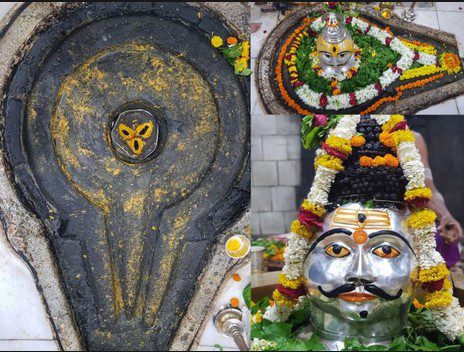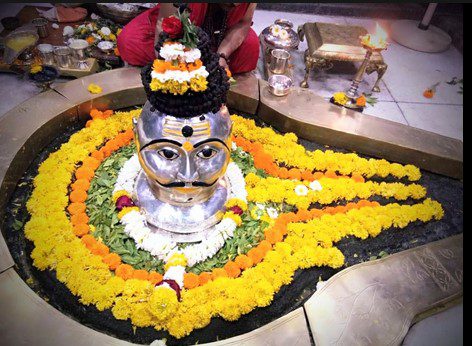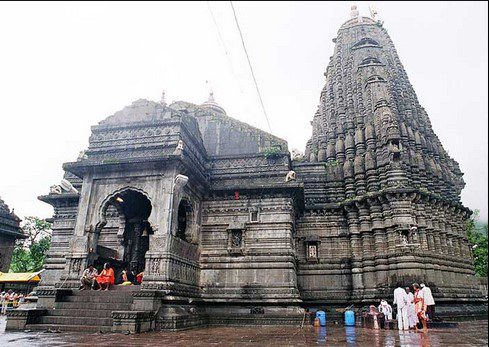Trimbakeshwar Jyotirlinga: A Divine Abode with Three Faces

Trimbakeshwar Jyotirlinga, located in Nashik, Maharashtra, is a revered place of worship that holds immense spiritual significance for Hindus. As one of the twelve Jyotirlingas, Trimbakeshwar represents the radiant form of Lord Shiva. Let us explore the legend, architecture, and the profound spiritual significance associated with Trimbakeshwar Jyotirlinga.
The Spiritual Significance of Trimbakeshwar Jyotirlinga Temple
Jyotirlingas are considered to be the most sacred shrines dedicated to Lord Shiva. They are believed to be self-manifested lingas (symbolic representations) of Lord Shiva’s powerful and divine presence. Trimbakeshwar Jyotirlinga, nestled in the serene surroundings of Nashik, is one such sacred abode.
Trimbakeshwar: One of the Twelve Jyotirlingas

Trimbakeshwar Jyotirlinga is counted among the twelve Jyotirlingas, which are considered highly auspicious and holy in Hinduism. Each of these Jyotirlingas is believed to radiate divine light, symbolizing the infinite cosmic power of Lord Shiva. Trimbakeshwar Jyotirlinga, with its unique features and spiritual legacy, attracts devotees from far and wide.
The Legend of Trimbakeshwar Jyotirlinga Temple
According to ancient Hindu mythology, the legend of Trimbakeshwar Jyotirlinga revolves around the revered sage Gautam Rishi. Gautam Rishi and his wife, Ahilya, were blessed with a divine boon that protected them from famine and ensured an abundance of food. This boon invoked jealousy among other rishis, who conspired to defame Gautam Rishi.
The Story of Gautam Rishi and the Jealous Rishis
In their malicious plan, the jealous rishis placed a dead cow in Gautam Rishi’s barn, accusing him of cow slaughter, which was considered a grave sin. Falsely accused and devastated by the allegations, Gautam Rishi turned to Lord Shiva for help and justice.
Lord Shiva’s Intervention and the Emergence of Trimbakeshwar
Deeply moved by Gautam Rishi’s devotion and innocence, Lord Shiva appeared before him and blessed the place with the divine Ganga River. The sacred river, known as Gautami Ganga, washed away the sins and impurities associated with the false accusation. Lord Shiva then manifested in the form of Trimbakeshwar Jyotirlinga and decided to reside there eternally, bestowing blessings upon all devotees who visit with faith and reverence.
Trimbakeshwar Temple: A Sacred Place of Worship

The Trimbakeshwar Temple, dedicated to Trimbakeshwar Jyotirlinga, is a magnificent structure that showcases remarkable architecture and spiritual symbolism.
Unique Features of the Temple Architecture
Unlike traditional temple structures, Trimbakeshwar Temple features a distinctive design. Instead of a shrine, there is a void with three pillars inside, symbolizing the presence of the three supreme deities of Hinduism – Brahma, Vishnu, and Maheshwar (Shiva).
Symbolism of the Three Faces
The three faces of Trimbakeshwar Jyotirlinga represent the divine Trinity of Hinduism. Brahma, the creator; Vishnu, the preserver; and Maheshwar (Shiva), the destroyer, collectively embody the cosmic balance and the cycle of life, death, and rebirth.
The Spiritual Significance of Jyotirlingas
Jyotirlingas hold immense spiritual significance for devotees. They are considered the focal points of cosmic energy and divine grace, allowing devotees to connect with the supreme consciousness. The pilgrimage to Trimbakeshwar Jyotirlinga offers a profound spiritual experience, enabling devotees to seek blessings, purify their souls, and attain spiritual upliftment.
How to Reach Trimbakeshwar Jyotirlinga
Situated amidst the picturesque Sahyadri mountain range, it offers a serene and tranquil atmosphere for spiritual seekers. Reaching Trimbakeshwar is convenient, with various transportation options available, including roadways, railways, and airways. To reach Trimbakeshwar Jyotirlinga, the nearest railway station is Nasik Road, located approximately 38 km away from the temple. From there, one can easily hire a taxi or an auto-rickshaw to reach the temple. as well as Trimbakeshwar is located in the Trimbak village, approximately 30 kilometers from Nasik city. For those traveling by air, Nashik Airport is the closest, situated around 50 km away or The another nearer airport is Mumbai’s Chhatrapati Shivaji International Airport which is 200 km away.
Accommodation Options
Trimbakeshwar provides a range of accommodation options to suit every traveler’s needs. From comfortable hotels and resorts to serene guesthouses and ashrams, you can find the perfect place to stay during your pilgrimage. These accommodations offer a peaceful ambiance and ensure a pleasant and convenient experience for devotees.
Rituals and Festivals
At Trimbakeshwar Jyotirlinga, visitors can witness and participate in the daily rituals conducted by the temple priests. These rituals create an atmosphere of devotion and spirituality, allowing devotees to connect with the divine. The temple also hosts several festivals throughout the year, with the most notable being Mahashivaratri, attracting thousands of devotees from far and wide.
Local Cuisine
Exploring Trimbakeshwar is incomplete without savoring the local cuisine. Indulge in authentic Maharashtrian delicacies such as Misal Pav, Vada Pav, and Puran Poli, which will tantalize your taste buds. Don’t miss out on the local food joints that serve these mouthwatering dishes, providing a culinary experience that complements your spiritual journey.
Shopping in Trimbakeshwar
Trimbakeshwar offers a variety of shopping options, allowing you to take home a piece of its divinity. Explore the local markets and shops to find souvenirs, religious artifacts, and traditional clothing. These mementos will serve as a cherished reminder of your pilgrimage to Trimbakeshwar.
Safety and Travel Tips
When visiting Trimbakeshwar, it is essential to take certain precautions to ensure a safe and fulfilling experience. Respect the religious customs and traditions of the place, dress modestly, and carry necessary items like sunscreen, hats, and comfortable footwear. It is advisable to visit during the cooler months, between October and March, to avoid extreme heat and crowds.
Nearby Attractions
Nasik City: Nasik, also known as Nashik, is a bustling city located near Trimbakeshwar Jyotirlinga. It is renowned for its historical and cultural significance. The city offers a blend of ancient temples, vibrant markets, and modern amenities. Devotees often visit Nasik as a part of their Trimbakeshwar pilgrimage to explore its rich heritage.
Pandavleni Caves: The Pandavleni Caves, also known as Trirashmi Caves, are a group of ancient Buddhist caves located on Trirashmi Hills in Nasik. These caves date back to the 2nd century BCE and showcase intricate rock-cut architecture and stunning sculptures. Exploring these caves provides a glimpse into the region’s rich Buddhist heritage and offers panoramic views of Nasik city.
Anjaneri Hills: Anjaneri Hills, named after Lord Hanuman’s mother, Anjani, is a scenic hill range located near Trimbakeshwar. It is believed to be the birthplace of Lord Hanuman and holds immense mythological significance. The hills offer picturesque trails for trekking enthusiasts, providing breathtaking views of the surrounding landscape and a serene atmosphere.
Panchavati: Panchavati is a sacred site in Nasik, closely associated with the Hindu epic, Ramayana. It is believed to be the place where Lord Rama, Sita, and Lakshmana stayed during their exile. Panchavati is home to various temples, including the famous Sita Gufa (cave), Kapaleshwar Temple, and Kalaram Temple. The serene Godavari River flowing through Panchavati adds to its tranquil charm, attracting devotees and nature lovers alike.
Find out more exciting best places to visit.Conclusion
Trimbakeshwar Jyotirlinga, with its divine presence and unique features, is a revered pilgrimage site for devotees seeking spiritual solace and blessings from Lord Shiva. The legend of Gautam Rishi, the magnificent architecture of Trimbakeshwar Temple, and the spiritual significance of Jyotirlingas make this place a must-visit for devout Hindus. Embark on a soul-stirring journey to Trimbakeshwar Jyotirlinga, immerse yourself in the divine aura, and experience the eternal bliss of Lord Shiva’s presence.
FAQ
1. What is the significance of Trimbakeshwar Jyotirlinga in Hinduism?
Ans: Trimbakeshwar Jyotirlinga is one of the twelve highly revered Jyotirlingas, representing the divine radiance of Lord Shiva. It holds immense spiritual significance for Hindus.
2. What is the unique feature of Trimbakeshwar Temple architecture?
Ans: Trimbakeshwar Temple showcases a distinctive design with a void and three pillars inside, symbolizing the presence of Brahma, Vishnu, and Maheshwar.
3. How can I reach Trimbakeshwar Jyotirlinga?
Ans: The nearest railway station to Trimbakeshwar Jyotirlinga is Nasik Road. Nashik Airport is the closest airport. Both can be reached through various transportation options.
4. What is the spiritual significance of Jyotirlingas?
Ans: Jyotirlingas are believed to radiate divine light and represent the infinite cosmic power of Lord Shiva. They serve as focal points for devotees to connect with the divine and seek spiritual upliftment.
5. Is Trimbakeshwar Jyotirlinga open for darshan every day?
Ans: Yes, Trimbakeshwar Jyotirlinga is open for devotees every day from 5:30 AM to 9 PM.
6. What is the best time to visit Trimbakeshwar?
Ans: The best time to visit Trimbakeshwar is during the cooler months between October and March when the weather is pleasant for exploring the temple and its surroundings.
7. Are there any accommodation options near Trimbakeshwar?
Ans: Yes, Trimbakeshwar offers a range of accommodation options, including hotels, resorts, guesthouses, and ashrams, ensuring a comfortable stay for visitors.
8. Can I visit Trimbakeshwar with my family?
Ans: Absolutely! Trimbakeshwar is a family-friendly destination, welcoming devotees of all ages to experience its spiritual aura and explore the nearby attractions.
9. What are some must-try local dishes in Trimbakeshwar?
Ans: When in Trimbakeshwar, don’t miss the opportunity to savor authentic Maharashtrian dishes like Misal Pav, Vada Pav, and Puran Poli, which are local delicacies.
10. Are there any restrictions for tourists at Trimbakeshwar?
Ans: While visiting Trimbakeshwar, it is important to respect the religious customs and traditions of the temple. Dress modestly and follow the guidelines provided by the temple authorities to ensure a harmonious visit

2 thoughts on ““Trimbakeshwar Jyotirlinga- 12 Jyotirlingas in India””